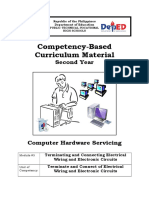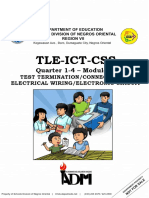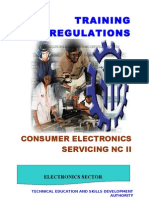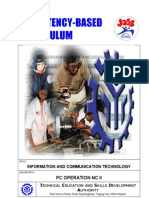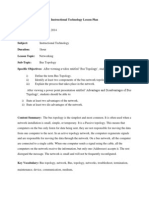Terminating and Connecting of Electrical Wirings and Electronics Circuits 2nd
Terminating and Connecting of Electrical Wirings and Electronics Circuits 2nd
Uploaded by
Victor Dagohoy DumaguitCopyright:
Available Formats
Terminating and Connecting of Electrical Wirings and Electronics Circuits 2nd
Terminating and Connecting of Electrical Wirings and Electronics Circuits 2nd
Uploaded by
Victor Dagohoy DumaguitCopyright
Available Formats
Share this document
Did you find this document useful?
Is this content inappropriate?
Copyright:
Available Formats
Terminating and Connecting of Electrical Wirings and Electronics Circuits 2nd
Terminating and Connecting of Electrical Wirings and Electronics Circuits 2nd
Uploaded by
Victor Dagohoy DumaguitCopyright:
Available Formats
HowtoUsethisModule....................................................................................................... Introduction.......................................................................................................................... TechnicalTerms.................................................................................................................... LearningOutcome#1.......................................................................................................... 1 InformationSheet#11....................................................................................................... 2 OperationSheet#11.......................................................................................................... 6 LearningOutcome#2.......................................................................................................... 8 InformationSheet#2.1....................................................................................................... 9 ActivitySheet#2.1............................................................................................................ 10 LearningOutcome#3........................................................................................................
13 JobSheet
PCHARDWARESERVICING
TheStrengthenedTechnicalVocationalEducationProgram
1|P a g e
Welcome to the Module Terminating and Connecting Electrical Wiring and Electronic Circuits. This module contains training materials and activities for you to complete. The unit of competency Terminate and Connect Electrical Wiring and Electronic Circuits contains knowledge, skills and attitudes required for a Computer Hardware Servicing NC II course. You are required to go through a series of learning activities in order to complete each of the learning outcomes of the module. In each learning outcome there are Job Sheets, and Activity Sheets. Follow these activities on your own and answer the Self-Check at the end of each learning activity. If you have questions, do not hesitate to ask your teacher for assistance. Recognition of Prior Learning (RPL) You may already have some of the knowledge and skills covered in this module because you have: o been working for some time o completed training in this area. If you can demonstrate to your teacher that you are competent in a particular skill or skills, talk to him/her about having them formally recognized so you do not have to do the same training again. If you have a qualification or Certificate of Competency from previous trainings show it to your teacher. If the skills you acquired are still current and relevant to this module, they may become part of the evidence you can present for RPL. If you are not sure about the currency of your skills, discuss it with your teacher. After completing this module ask your teacher to assess your competency. Result of your assessment will be recorded in your competency profile. All the learning activities are designed for you to complete at your own pace. Inside this module you will find the activities for you to complete followed by relevant information sheets for each learning outcome. Each learning outcome may have more than one learning activity. HARDWARESERVICING PC
TheStrengthenedTechnicalVocationalEducationProgram
2|P a g e
Program/Course Unit of Competency Module : : : Computer Hardware Servicing NC II Terminate and Connect Electrical Wiring and Electronic Circuits Terminating and Connecting Electrical Wiring and Electronic Circuits
INTRODUCTION
Thismodule contains information andsuggestedlearningactivitiesonComputerHardware Servicing NC II. It includes the following competencies: plan and prepare for termination/ connections of electrical wiring/electronic circuits, terminate/connect electrical wiring/electronic circuits,andtesttermination/connectionsofelectricalwiring/electroniccircuits. It consists of three (3) learning outcomes. Each learning outcome contains learning activities supported by each instructional sheet. Upon completion of this module, report to your teacher to assess your achievement of knowledge and skills requirement of this module. If you pass the assessment,youwillbegivenacertificateofcompletion.
SUMMARYOFLEARNINGOUTCOMES: LO1. LO2. LO3. REFERENCES: 1. Agpaoa,Feliciano,InteriorandExteriorWiringTroubleshooting,NationalbooksStore,1991 2. Enriquez, Michael, Simple Electronics (Basic) Fully Illustrated, Antonio M. Andes Sr. ElectronicsBookSeries 3. www.electronicslab.com 4. www.wikipedia.com Uponcompletionofthemoduleyoushouldbeableto: Planandprepareforterminationandconnectionofelectricalwiringandelectroniccircuits. Terminateandconnectelectricalwiringandelectroniccircuits. TestTerminationandconnectionofelectricalwiringand/electroniccircuit.
PCHARDWARESERVICING
TheStrengthenedTechnicalVocationalEducationProgram
3|P a g e
Voltage The measure of the push on each electron which makes the electron move. The term potential difference and voltage are often used interchangeably to mean the push, thus, you may see the term electromotive force (EMF) or just the word potential to describe the electronpushincertaininstances.
Current Resistance Power Resistor Adevicedesignedintentionallytohaveadefiniteamountof Therateofdoingwork. Theoppositiontocurrentflow. Theflowofelectronsinthecircuit.
resistance Capacitor Adevicethatstoreselectricalenergy.
Termination
OHS
- The point where a line, channel or circuit ends.
OccupationalHealthandSafety
PCHARDWARESERVICING
TheStrengthenedTechnicalVocationalEducationProgram
4|P a g e
Program/Course UnitofCompetency Module#3 : ComputerHardwareServicingNCII : TerminateandConnectElectricalWiringandElectronic Circuits : TerminatingandConnectingElectricalWiringandElectronic Circuits LearningOutcome1:PlanandPrepareforTerminationandConnectionofElectrical WiringandElectronicCircuits
AssessmentCriteria: 1. 2. 3. 4. Materialsarecheckedaccordingtospecificationsandtask. Appropriatetoolsandequipmentareselectedaccordingtotaskrequirements. TaskisplannedtoensurethatOHSguidelinesandproceduresarefollowed. Electricalwiringelectronicscircuitsareappropriatelypreparedforconnection/ terminationinaccordancewithinstructionsandworksiteprocedure. References: 1. Agpaoa, Feliciano, Interior and Exterior Wiring Troubleshooting, National books Store,1991 2. Enriquez, Michael, Simple Electronics (Basic) Fully Illustrated, Antonio M. Andes Sr. ElectronicsBookSeries 3. Cardenas, Elpidio, Fundamentals and Elements of Electricity, National Book Store, 1991 4. www.wikipedia.com
PCHARDWARESERVICING
TheStrengthenedTechnicalVocationalEducationProgram
5|P a g e
DirectCurrentandAlternatingCurrent DirectCurrentorDCisthefirsttypeofcurrentbecauseitwaseasytoproduce.Thistypeof current always flows in one direction. One of the disadvantages of using DC is the excessive voltagedrop andpower loss in the power linesina long distance transmission. Batteries are commonsourcesofdirectcurrent. Alternating Current or AC is the solution to the problem of DC. AC allows the flow of current in two directions. Today, it is possible to stepup electricity, a power station, transmit it to anydistantplaceandstepitdowntoforconsumption.Atransformeristhedeviceusedfor steppingup or steppingdown AC voltage. Common sources of AC are found in our AC outlet(Typically,220volts,inthePhilippines).
ACandDCWaveForm
OHMSLAWANDPOWERLAW Ohms law states that, for a constant current, the current in a circuit is directly proportional to the total voltage acting in the circuit and inversely proportional to the totalresistanceofthecircuit. HARDWARESERVICING PC
TheStrengthenedTechnicalVocationalEducationProgram
6|P a g e
ThelawmaybeexpressedbythefollowingequationifthecurrentIisinamperes,EMFEis involts,andtheresistanceRisinohms. The relationship of the foregoing three variables was discovered by Georg Simon Ohm, who theorized that current is in direct proportion to resistance. The relationship is explainedalgebraically,usingthisformula: where:
Resistance Voltage
R = E/I
E=IxR
I = E/R
Current
E EMF in Volts R Resistance I Current in Amperes
PCHARDWARESERVICING
TheStrengthenedTechnicalVocationalEducationProgram
7|P a g e
A. PracticeProblems: 1.
I=? E=25V Required R=25 G. I H. P
2.
I=9A E=? Required E. E F. P
R=72
I=25A E=?
Required P=100W C. R D. E
PCHARDWARESERVICING
TheStrengthenedTechnicalVocationalEducationProgram
8|P a g e
3.
I=4.5A E=? Required A. E B. R
P=350W
PCHARDWARESERVICING
TheStrengthenedTechnicalVocationalEducationProgram
9|P a g e
ASimplecircuitcontainstheminimumthingsneededtohaveafunctioningelectric circuit.Asimplecircuitrequiresthefollowing: AC/DCsource EquipmentthatwilloperateoneitheranACorDCpowersource Battery A dc voltage source containing two or more cells that convert chemicalenergytoelectricalenergy. Cell Single unit used to convert chemical energy into a DC electrical voltage. FUSE Onceyoudesignasimplecircuitonelectronics,it isimportanttoincludea fuse in the primary or secondaryofatransformer. Fuse is a safety device used to protect an electrical circuit from the effect of excessive current. Its essential component is usually a strip of metal that will melt at a given temperature. A fuse is so designed that the strip of metal can easily be placed in the electric circuit. If the current in the circuit exceed a predeterminedvalue,thefusiblemetalwillmeltandthusbreak,oropen thecircuit. A fuse is usually rated in Amperes, which represent the maximum continuouscurrentitcouldhandlewithoutblowing. The most popular type of fuse in Electronics is 3AG type. This code describes the case size and material where G indicates a glass materials and A indicates that intended for automotive application. A 3AGfusemeasuresapproximately32mmx6mm.
WiresandCable A wire is a single slender rod or filament of drawn metal. This definition restricts the term to what would ordinarily be understood as solid wire. The word slender is used because the length of a wire is usually large when compared to its diameter. If a wire is covered with insulation, It is an insulated wire. Although the term wire properly refers to themetal,italsoincludestheinsulation. A conductor is a wire suitable for carrying anelectriccurrent.
PCHARDWARESERVICING
TheStrengthenedTechnicalVocationalEducationProgram
10|P a g e
A stranded conductor is a conductor composed of a group of wire or any combination of group of wires. The wires in a stranded conductor are usually twistedtogetherandnotinsulatedfromeachother. A cable is either a stranded conductor (singleconductor cable) or a combination of conductors insulated from one another (multipleconductor cable). The term cable is a general one and usually applies only to the large sizes of conductor. A small cable is more often called a stranded wire or cord (such as that used for an iron or a lamp cord). Cables may be bare or insulated. Insulatedcablesmaybesheathed(covered)withlead,orprotectivearmor. Switchanditsfunction Switch is a device used to break an electric current or transfer it to another conductor. Switches are commonly used to open or close a circuit. Closed is the ON position, while open is OFF position. Normally, switch is installed in series with the line carrying current from thepowersourcetotheload. A switch is a mechanical device used to connect and disconnect a circuit at will. Switches cover a wide range of types, from subminiature up to industrial plant switching megawatts of power on high voltagedistributionlines. Switch is a manually operated device capable of making, breaking, or changing the connection in an electronics or electrical circuit. A switch connected in series with one of the connecting wires of simple circuit affords a means of controllingthecurrentinthecircuit. Switchfunction o When the switch is closed, the electron finds an interrupted path in the circuit. o OpenistheOFFpositionoftheswitch,whileclosedistheONposition. o When the switch is opened, the current delivered by the power supply is normally insufficient to jump the switch gap in the form of an arc and the electronflowinthecircuitisblocked.
Load a source drives a load. Whatever component or piece of equipment is connectedtoasourceanddrawscurrentfromasourceisaloadonthatsource. o Thefollowingareexamplesbutnotlimitedto: Bulb Appliances
PCHARDWARESERVICING
TheStrengthenedTechnicalVocationalEducationProgram
11|P a g e
I. ClassificationsofElectronicComponent A. Passive devices A Passive Device is one that contributes no power gain (amplification) to a circuit or system. It has no control action and does not requireanyinputotherthanasignaltoperformitsfunction.Inotherwords, "A component with no brains!" Examples are Resistors, Capacitors and Inductors. RESISTOR Thisisthemostcommoncomponentinelectronics. It is used mainly to control current and voltage within the circuit. You can identify a simple resistor by its simple cigar shape with a wire lead coming out of each end. It uses a system of color coded bands to identify the value of the component (measuredinOhms)
It is charged with a magnetic field and when that field collapses it produces current in the opposite direction. Inductors are used in Alternating Current circuitstoopposechangesintheexistingcurrent. Capacitors, or "caps", vary in size and shape from a small surface mount model up to a huge electric motor cap the size of paint can. Whatever the size or shape, the purpose is the same. It stores electricalenergyintheformofelectrostaticcharge.
PCHARDWARESERVICING
TheStrengthenedTechnicalVocationalEducationProgram
12|P a g e
B. Active Devices are components that are capable of controlling voltages or currents and can create a switching action in the circuit. In other words, "Devices with smarts!" Examples are Diodes, Transistors and Integrated circuits. Diodes are basically a oneway valve for electrical current. They let it flow in one direction (from positivetonegative)andnotintheotherdirection. Most diodes are similar in appearance to a resistor andwillhaveapaintedlineononeendshowingthe direction or flow (white side is negative). If the negative side is on the negative end of the circuit, current will flow. If the negative is on the positive sideofthecircuitnocurrentwillflow. LEDs are simply diodes that emit light of one form or another. They are used as indicator devices. Example: LED lit equals machine on. They come in several sizes and colors. Some even emit Infrared Lightwhichcannotbeseenbythehumaneye.
HARDWARESERVICING PC
TheStrengthenedTechnicalVocationalEducationProgram
The transistor is possibly the most important invention of this decade. It performs two basic functions. 1) It acts as a switch turning current on and off. 2) It acts as an amplifier. This makes an output signal that is a magnified version of the inputsignal. Integrated Circuits, or ICs, are complex circuits inside one simple package. Silicon and metals are used to simulate resistors, capacitors, transistors, etc.Itisaspacesavingmiracle.
13|P a g e
ELECTRONICSCHEMATICSYMBOLS
Wiresandconnections Component Wire CircuitSymbol FunctionofComponent Topasscurrentveryeasilyfromonepartof acircuittoanother. A'blob'shouldbedrawnwherewiresare connected(joined),butitissometimes omitted.Wiresconnectedat'crossroads' shouldbestaggeredslightlytoformtwoT junctions,asshownontheright. Incomplexdiagramsitisoftennecessaryto drawwirescrossingeventhoughtheyare notconnected.Ipreferthe'bridge'symbol shownontherightbecausethesimple crossingontheleftmaybemisreadasa jointwhereyouhaveforgottentoadda 'blob'!
Wiresjoined
Wiresnotjoined
PowerSupplies/Source Component CircuitSymbol FunctionofComponent Supplieselectricalenergy. Thelargerterminal(ontheleft)ispositive(+). Asinglecellisoftencalledabattery,but strictlyabatteryistwoormorecellsjoined together. Supplieselectricalenergy.Abatteryismore thanonecell. Thelargerterminal(ontheleft)ispositive(+). Supplieselectricalenergy. DC=DirectCurrent,alwaysflowinginone direction.
Cell
Battery
DCsupply
PCHARDWARESERVICING
TheStrengthenedTechnicalVocationalEducationProgram
14|P a g e
ACsupply
Supplieselectricalenergy. AC=AlternatingCurrent,continuallychanging direction. Asafetydevicewhichwill'blow'(melt)ifthe currentflowingthroughitexceedsaspecified value. Twocoilsofwirelinkedbyanironcore. Transformersareusedtostepup(increase) andstepdown(decrease)ACvoltages.Energy istransferredbetweenthecoilsbythe magneticfieldinthecore.Thereisnoelectrical connectionbetweenthecoils. Aconnectiontoearth.Formanyelectronic circuitsthisisthe0V(zerovolts)ofthepower supply,butformainselectricityandsome radiocircuitsitreallymeanstheearth.Itisalso knownasground.
Fuse
Transformer
Earth (Ground)
OutputDevices/Loads:Lamps,Heater,Motor Component CircuitSymbol FunctionofComponent Atransducerwhichconvertselectrical energytolight.Thissymbolisusedfora lampprovidingillumination,forexamplea carheadlamportorchbulb. Atransducerwhichconvertselectrical energytolight.Thissymbolisusedfora lampwhichisanindicator,forexamplea warninglightonacardashboard. Atransducerwhichconvertselectrical energytoheat. Atransducerwhichconvertselectrical energytokineticenergy(motion).
Lamp(lighting)
Lamp(indicator)
Heater
Motor
PCHARDWARESERVICING
TheStrengthenedTechnicalVocationalEducationProgram
15|P a g e
Bell
Atransducerwhichconvertselectrical energytosound.
Buzzer Inductor (Coil,Solenoid) Switches Component PushSwitch (pushto make) PushtoBreak Switch OnOffSwitch (SPST) CircuitSymbol
Atransducerwhichconvertselectrical energytosound.
Acoilofwirewhichcreatesamagneticfield whencurrentpassesthroughit.Itmayhave anironcoreinsidethecoil.Itcanbeused asatransducerconvertingelectricalenergy tomechanicalenergybypullingon something.
FunctionofComponent Apushswitchallowscurrenttoflowonlywhenthe buttonispressed.Thisistheswitchusedtooperatea doorbell. Thistypeofpushswitchisnormallyclosed(on);itis open(off)onlywhenthebuttonispressed. SPST=SinglePole,SingleThrow. Anonoffswitchallowscurrenttoflowonlywhenit isintheclosed(on)position. SPDT=SinglePole,DoubleThrow. A2waychangeoverswitchdirectstheflowof currenttooneoftworoutesaccordingtoitsposition. SomeSPDTswitcheshaveacentraloffpositionand aredescribedas'onoffon'.
2waySwitch (SPDT)
PCHARDWARESERVICING
TheStrengthenedTechnicalVocationalEducationProgram
16|P a g e
DualOnOff Switch (DPST) Completethetablebelow:
DPST=DoublePole,SingleThrow. Adualonoffswitchwhichisoftenusedtoswitch mainselectricitybecauseitcanisolateboththelive andneutralconnections.
A. Identifyeachofthesesymbols: COMPONENTS 1. 2. 3. 4. SYMBOLS
5.
PCHARDWARESERVICING
TheStrengthenedTechnicalVocationalEducationProgram
17|P a g e
B. Identifythefollowingbasicelectroniccomponents COMPONENT 1. 2. 3. 4. FIGURE
PCHARDWARESERVICING
TheStrengthenedTechnicalVocationalEducationProgram
18|P a g e
A simple circuit contains the minimum things needed to have a functioning electric circuit SourceadeviceusedtosupplyACorDCvoltage Consuminganydevicethatconsumesvoltage,whatevercomponentorpieceof equipment that is connected to a source and draws current from a source is a loadonthatsource. Controlling any device having two states, on (closed) or off (open). Ideally havingzeroimpedancewhenclosedandinfiniteimpedancewhenopen. Protectinga component used to open the circuit when current exceeds a predeterminedmaximumvalue. Connecting a material that conducts electric current very well and used to connectacompletepathforcurrent.
source
CONTROLLING
CONSUMING
Connecting device
ProcedureinCircuitDesigning 1. Prepareallthetoolsandmaterialsneeded. 2. Byusingschematicsymbol,makeasimplecircuitwiththefollowing: a. load b. consumingdevice c. protectingdevice d. consumingdevice e. connectingdevice 3. Make sure that the circuit has the following requirement that a simplecircuitmusthave: a. Asourceofelectricalpotentialdifferenceorvoltage. b. A conductive path which would allow for the movementofcharges. c. Anelectricalresistancewhichislooselydefinedasany objectthatuseselectricitytodowork. 4. Test the designed circuit by comparing it with the sample circuit producedbyyourteacher.
PCHARDWARESERVICING
TheStrengthenedTechnicalVocationalEducationProgram
19|P a g e
A.Fillintheblankswithwhatisreferredtobyeachofthefollowing. 1._______________________ Interconnection of components which provides an electricalpathbetweentwoormorecomponents. 2._______________________ Atypeofcircuitinwhichtheflowofcurrentiscutoff. 3._______________________ A circuit in which the components are connected from end to end so that the current has only one path to followthroughthecircuit. 4._______________________ A circuit where there is more than one path for the currenttoflowthrough. 5._______________________ AdeviceusedtosupplyACorDCvoltage. 6._______________________ Anydevicehavingtwostates,ONorOFF. 7._______________________ Asafetydeviceusedtoprotectanelectricalcircuit fromtheeffectofexcessivecurrent. 8._______________________ pathwayforcarryinganelectricalcurrent. 9._______________________ Components or pieces of equipment connected to a source whichdrawscurrentfromasource. 10._______________________ A DC voltage source containing two or more cells that convertchemicalenergytoelectricalenergy.
PCHARDWARESERVICING
TheStrengthenedTechnicalVocationalEducationProgram
20|P a g e
A. 1. Connectthetestprobetotheappropriatejack. Theredtestprobetothepositive(+)jackandtheblacktothecommon()jack. 2. Checkifthepointerrestsexactlyattheinfinitezeropositioninohmmeterrange.
COM (Black) +POS (Red)
InitialStepsinUsingAnalogMultitester
PCHARDWARESERVICING
TheStrengthenedTechnicalVocationalEducationProgram
21|P a g e
3. Checktheprobesiftheyareincondition.(Ohmmetercalibration) a. SettheMultitestertocorrespondingselectorresistancerange. b. Shortthetwotestprobesleadtogether.
Note: ZeroOhm Adjustment knob
Thepointershoulddeflect towardszeroohmreading
PCHARDWARESERVICING
TheStrengthenedTechnicalVocationalEducationProgram
22|P a g e
Adjust the ohm adjustment if the pointer could not rest exactly at O ohm reading.
Zero ohm
B.
As indicated, the pointer rests out of the range of ohmmeter scale. Adjust the ohm adjustment counter clockwise until the pointer rests O ohm reading.
ResistanceMeasurements 1. AlwaysdotheInitialStepsinUsingAnalogMultitester. 2. In testing resistors, capacitors, diodes etc. do not touch both test probe lead, because our body also has resistance that could affect the reading value of the electroniccomponentswearetesting. 3. If you do not know the value of the resistor to be measured, find the ohmmeter selectorsettinguntilyouhaveaclearreadingintheohmmeterscale.
OhmmeterScale (FrominfinitetoZero) InfiniteResistance openresistorOpen connectionor
Ohm Adjustment
OhmmeterSelector Range (x1,x10,x1K,x10K ohms)
PCHARDWARESERVICING
TheStrengthenedTechnicalVocationalEducationProgram
23|P a g e
4. Selectthedesiredresistancerangescalewithselectorswitch. HARDWARESERVICING PC
TheStrengthenedTechnicalVocationalEducationProgram
24|P a g e
Testinga55Kohmresistance Range:x10Kohm
Thepointerstopsat5.5inx10K rangeonselectorswitch
Testinga55Kohmresistance Range:x1Kohm
The setting (x1K in 56K Ohm resistor) is not an advisablesettingintesting55Kohmsresistance.Because, the pointer stops somewhere in 50. You cannot clearly readtheresistancevalue,unlikeinx10Kohmsetting.
HARDWARESERVICING PC
TheStrengthenedTechnicalVocationalEducationProgram
25|P a g e
You might also like
- Electronic Products Assembly and Servicing (Epas) Quarter 1: Learner'S MaterialDocument26 pagesElectronic Products Assembly and Servicing (Epas) Quarter 1: Learner'S MaterialGinger Fay Del RosarioNo ratings yet
- Accreditation of Assessment Centers QAS-031-CER-09Document48 pagesAccreditation of Assessment Centers QAS-031-CER-09Victor Dagohoy Dumaguit80% (10)
- Lesson Plan-Making A Twisted-Pair Cable With A rj45 Connector Jmeck Wfed495c-3 V3a6Document3 pagesLesson Plan-Making A Twisted-Pair Cable With A rj45 Connector Jmeck Wfed495c-3 V3a6api-312884329100% (2)
- Module 3 Terminate and Connect of Electrical Wiring and Electronic CircuitsDocument20 pagesModule 3 Terminate and Connect of Electrical Wiring and Electronic CircuitsAnne Atienza Garcia75% (4)
- Computer System Servicing NC IIDocument11 pagesComputer System Servicing NC IIEuropez Alaskha100% (1)
- TLE ICT 10 - Install An Application Software - Activity SheetDocument5 pagesTLE ICT 10 - Install An Application Software - Activity SheetGioSanBuenaventuraNo ratings yet
- Ismael Manic Balana Css PresentationsDocument23 pagesIsmael Manic Balana Css Presentationsวงกลม มิ.ย.No ratings yet
- Terminate and Connect Electrical WiringDocument17 pagesTerminate and Connect Electrical WiringArthur CapawingNo ratings yet
- Module 6 - Terminating and ConnectingDocument44 pagesModule 6 - Terminating and ConnectingMary Jane Blanco FioNo ratings yet
- CSS Terminating and Connerting Electrical Wiring and Electronic CircuitsDocument19 pagesCSS Terminating and Connerting Electrical Wiring and Electronic CircuitsRalfh Pescadero De GuzmanNo ratings yet
- Grade8 Q1-4 W7 TestTerminationAndConnectionDocument13 pagesGrade8 Q1-4 W7 TestTerminationAndConnectionjhun cuizonNo ratings yet
- CSS - Q2 - Week 7 - BNHSDocument4 pagesCSS - Q2 - Week 7 - BNHSNathaniel MirandaNo ratings yet
- Tle CSS Module 5 - Terminating and Connecting Electrical Wiring and Electronic CircuitDocument21 pagesTle CSS Module 5 - Terminating and Connecting Electrical Wiring and Electronic CircuitCrauxz de TraxNo ratings yet
- CHS Module 4 Install Computer Systems and NetworksDocument72 pagesCHS Module 4 Install Computer Systems and NetworksRodel MoralesNo ratings yet
- g8 Computer Hardware Servicing CGDocument7 pagesg8 Computer Hardware Servicing CGRia SorioNo ratings yet
- Testing Criteria in Electronics ComponentsDocument18 pagesTesting Criteria in Electronics ComponentsNelz Lum Montecalavz100% (3)
- SHS DLL Week 9Document2 pagesSHS DLL Week 9MELAIDA CASTANAR GARIBAYNo ratings yet
- How To Use This Competency-Based Learning MaterialDocument10 pagesHow To Use This Competency-Based Learning Materiallourdes estopaciaNo ratings yet
- Yoyoy 2 - CBLM COMMON TEST ELECTRONIC COMPONENTSDocument28 pagesYoyoy 2 - CBLM COMMON TEST ELECTRONIC COMPONENTSGlaiza Magistrado Monte0% (1)
- VTVS K To 12 PC Computer Systems Servicing Learning ModuleDocument131 pagesVTVS K To 12 PC Computer Systems Servicing Learning ModuleEuropez Alaskha90% (10)
- Semi - Detailed Lesson Plan in Tle-Ict (CSS)Document3 pagesSemi - Detailed Lesson Plan in Tle-Ict (CSS)angel grace turaldeNo ratings yet
- Division of Guihulngan City: Iva-J-33Document2 pagesDivision of Guihulngan City: Iva-J-33nairdapunk100100% (1)
- Tle Daily Lesson Log: A. Content StandardDocument2 pagesTle Daily Lesson Log: A. Content StandardFidel B. DiopitaNo ratings yet
- Modified Daily Lesson Plan: Meycauayan National High SchoolDocument3 pagesModified Daily Lesson Plan: Meycauayan National High SchoolAdrian Baguna MontemorNo ratings yet
- Performing Mensuration and Calculation (PMC)Document109 pagesPerforming Mensuration and Calculation (PMC)Diana Ross Dayrit Diaz94% (18)
- Las Css 9 2nd Quarter - Padapada National HsDocument3 pagesLas Css 9 2nd Quarter - Padapada National HsAlex ReyesNo ratings yet
- Install Network CablesDocument17 pagesInstall Network CablesPEAC RELATEDNo ratings yet
- A GRADE 11 Q1M2 TeacherDocument33 pagesA GRADE 11 Q1M2 TeacherRusty Ugay LumbresNo ratings yet
- Technical Vocational Livelihood - ICTDocument22 pagesTechnical Vocational Livelihood - ICTPinagtongulan NHS (Region IV-A - Lipa City)100% (1)
- 2ND Quarter CSS 12 Week 3-4Document6 pages2ND Quarter CSS 12 Week 3-4Jubert PadillaNo ratings yet
- Sisters of Mary Technical Education Institute, Inc.: J.P. Rizal Street, Poblacion, City of Talisay 6045, CebuDocument2 pagesSisters of Mary Technical Education Institute, Inc.: J.P. Rizal Street, Poblacion, City of Talisay 6045, CebuHelloitsMarnNo ratings yet
- Ict - CSS 9Document14 pagesIct - CSS 9Lawrence LongcopNo ratings yet
- CSS NC-2 Topic 1 - Exploring The Electronics IndustryDocument45 pagesCSS NC-2 Topic 1 - Exploring The Electronics IndustryChelie TrangiaNo ratings yet
- COMPETENCY BASED LEARNING MATERIAL Setup Computer NetworkDocument32 pagesCOMPETENCY BASED LEARNING MATERIAL Setup Computer NetworkArvincent Geronimo OlatanNo ratings yet
- Css-Grade 11 - Finals-Module - Lesson 4Document7 pagesCss-Grade 11 - Finals-Module - Lesson 4Cathleen BethNo ratings yet
- Budget of Lesson: Computer Systems Servicing Grade 12Document6 pagesBudget of Lesson: Computer Systems Servicing Grade 12Jerry G. GabacNo ratings yet
- SHS DLL Q2 - w7Document2 pagesSHS DLL Q2 - w7MELAIDA CASTANAR GARIBAY100% (1)
- ICT CompSysServicing11 Q4 LAS1 FINALDocument8 pagesICT CompSysServicing11 Q4 LAS1 FINALBula NHS (Region V - Camarines Sur)100% (1)
- A. Preliminary Activity:: Integration With English LiteracyDocument6 pagesA. Preliminary Activity:: Integration With English LiteracyLima AlphaNo ratings yet
- Computer Systems Servicing ContentsDocument21 pagesComputer Systems Servicing ContentsManuelo VangieNo ratings yet
- TR - Consumer Electronics Servicing NC IIDocument78 pagesTR - Consumer Electronics Servicing NC IIartcase100% (2)
- Department of Education: Republic of The PhilippinesDocument5 pagesDepartment of Education: Republic of The PhilippinesKay Tracey Urbiztondo100% (1)
- CSS 11 - Q1 DIAGNOSTIC TEST - No AnswerDocument4 pagesCSS 11 - Q1 DIAGNOSTIC TEST - No AnswerJanelkris PlazaNo ratings yet
- ICT CompSysServicing11 Q4 LAS2 FINALDocument9 pagesICT CompSysServicing11 Q4 LAS2 FINALJDNo ratings yet
- Name of Learner: - Grade & SectionDocument10 pagesName of Learner: - Grade & SectionAxel Nicerio RoveloNo ratings yet
- 1 Information Sheet 1.1-1Document3 pages1 Information Sheet 1.1-1jhon lurym delos santosNo ratings yet
- PC Operations NC IIDocument61 pagesPC Operations NC IIzninoromeo100% (2)
- Session Plan Electric FanDocument6 pagesSession Plan Electric FanEdenezer Rosario100% (1)
- CSS Budget of WorkDocument5 pagesCSS Budget of WorkAldrin EsperidaNo ratings yet
- BOW - CSS 10 - Quarter 2Document2 pagesBOW - CSS 10 - Quarter 2CHRISTINE RODRIGUEZNo ratings yet
- Tle Ict Css Lesson Competencies AssesmentDocument4 pagesTle Ict Css Lesson Competencies AssesmentElvis100% (1)
- It Lesson PlanDocument3 pagesIt Lesson Planapi-25811821450% (2)
- SHS DLLDocument3 pagesSHS DLLMELAIDA CASTANAR GARIBAYNo ratings yet
- Terminating and Connecting of Electrical Wirings and Electronics Circuits - Part1Document43 pagesTerminating and Connecting of Electrical Wirings and Electronics Circuits - Part1Ronaldo PalomaNo ratings yet
- Terminating and Connecting of Electrical Wirings and Electronics Circuits - Part1 PDFDocument43 pagesTerminating and Connecting of Electrical Wirings and Electronics Circuits - Part1 PDFgerwin100% (1)
- PC Hardware Servicing: The Strengthened Technical Vocational Education ProgramDocument25 pagesPC Hardware Servicing: The Strengthened Technical Vocational Education Programzkalel_mNo ratings yet
- Terminating and Connecting of Electrical Wirings and Electronics Circuits 2ndDocument28 pagesTerminating and Connecting of Electrical Wirings and Electronics Circuits 2ndJellyOñaRedondoNo ratings yet
- Electronics Y4Document211 pagesElectronics Y4Ronaldo PalomaNo ratings yet
- TLE - EPAS - Y2 - Module 4 - Terminating and Connecting of Electrical Wiring and Electronic CircuitDocument47 pagesTLE - EPAS - Y2 - Module 4 - Terminating and Connecting of Electrical Wiring and Electronic CircuitGIRLY PEDREGOSANo ratings yet
- CBLM CHS NC2 Terminating and Connect of Electrical Wiring and Electronic CircuitsDocument20 pagesCBLM CHS NC2 Terminating and Connect of Electrical Wiring and Electronic CircuitsEleunamme Zx67% (9)
- Y4 Module 1 Maintaining and Repairing Audio Products and SystemDocument48 pagesY4 Module 1 Maintaining and Repairing Audio Products and Systemtxm4kb4h46No ratings yet
- DLL Week1 Org.Document3 pagesDLL Week1 Org.Victor Dagohoy Dumaguit50% (2)
- Cert. of ExpensesDocument1 pageCert. of ExpensesVictor Dagohoy DumaguitNo ratings yet
- Table of Specifications: 4Th Quarter Test English IiiDocument4 pagesTable of Specifications: 4Th Quarter Test English IiiVictor Dagohoy DumaguitNo ratings yet
- Billing StatementDocument1 pageBilling StatementVictor Dagohoy DumaguitNo ratings yet
- MIS 03-02 2015twspDocument10 pagesMIS 03-02 2015twspVictor Dagohoy DumaguitNo ratings yet
- Video Card PDFDocument12 pagesVideo Card PDFVictor Dagohoy DumaguitNo ratings yet
- Application Sheet For GPDocument4 pagesApplication Sheet For GPVictor Dagohoy DumaguitNo ratings yet
- Competency Based Learning Material: Maintaining Computer System and NetworksDocument35 pagesCompetency Based Learning Material: Maintaining Computer System and NetworksVictor Dagohoy DumaguitNo ratings yet
- Develop and Update Industry Knowledge, 4th Edition-1Document68 pagesDevelop and Update Industry Knowledge, 4th Edition-1Victor Dagohoy Dumaguit50% (2)
- Computer Hardware Servicing: Tuesday, October 26, 2010Document6 pagesComputer Hardware Servicing: Tuesday, October 26, 2010Victor Dagohoy DumaguitNo ratings yet
- Computer Hardware Servicing NCIIDocument78 pagesComputer Hardware Servicing NCIINoone F. moonNo ratings yet
- Develop and Update Industry Knowledge, 4th Edition-1Document68 pagesDevelop and Update Industry Knowledge, 4th Edition-1Victor Dagohoy Dumaguit50% (2)



